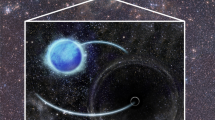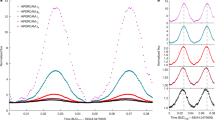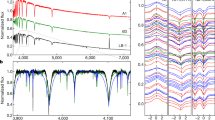Abstract
Tests of Einstein’s general theory of relativity have mostly been carried out in weak gravitational fields where the space-time curvature effects are first-order deviations from Newton’s theory1,2,3,4,5,6. Binary pulsars4 provide a means of probing the strong gravitational field around a neutron star, but strong-field effects may be best tested in systems containing black holes7,8. Here we report such a test in a close binary system of two candidate black holes in the quasar OJ 287. This quasar shows quasi-periodic optical outbursts at 12-year intervals, with two outburst peaks per interval9,10. The latest outburst occurred in September 2007, within a day of the time predicted by the binary black-hole model and general relativity11. The observations confirm the binary nature of the system and also provide evidence for the loss of orbital energy in agreement (within 10 per cent) with the emission of gravitational waves from the system12. In the absence of gravitational wave emission the outburst would have happened 20 days later13.
This is a preview of subscription content, access via your institution
Access options
Subscribe to this journal
Receive 51 print issues and online access
$199.00 per year
only $3.90 per issue
Buy this article
- Purchase on Springer Link
- Instant access to full article PDF
Prices may be subject to local taxes which are calculated during checkout


Similar content being viewed by others
References
Misner, C. W., Thorne, K. S. & Wheeler, J. A. Gravitation (Freeman, San Francisco, 1973)
Pound, R. V. & Rebka, G. A. Gravitational redshift in nuclear resonance. Phys. Rev. Lett. 3, 439–441 (1959)
Taylor, J. H. & Weisberg, J. M. Further experimental tests of relativistic gravity using the binary pulsar PSR1913+16. Astrophys. J. 345, 434–450 (1989)
Hulse, R. A. The discovery of the binary pulsar. Rev. Mod. Phys. 66, 699–710 (1994)
Walsh, D., Carswell, R. F. & Weymann, R. J. 0957 + 561 A, B: twin quasistellar objects or gravitational lens? Nature 279, 381–384 (1979)
Ciufolini, I. & Pavlis, E. C. A confirmation of the general relativistic prediction of the Lense–Thirring effect. Nature 431, 958–960 (2004)
Cui, W., Zhang, S. N. & Chen, W. Evidence for frame dragging around spinning black holes in X-ray binaries. Astrophys. J. 492, L53–L57 (1998)
Bromley, B. C., Miller, W. A. & Pariev, V. I. The inner edge of the accretion disk around a supermassive black hole. Nature 391, 54–56 (1998)
Sillanpää, A., Haarala, S., Valtonen, M. J., Sundelius, B. & Byrd, G. G. OJ287 – Binary pair of supermassive black holes. Astrophys. J. 325, 628–634 (1988)
Lehto, H. J. & Valtonen, M. J. OJ287 outburst structure and a binary black hole model. Astrophys. J. 460, 207–213 (1996)
Valtonen, M. J. OJ287: A binary black hole system. Rev. Mex. Astron. Astrofis. Conf. Ser. (in the press)
Valtonen, M. J. & Lehto, H. J. Outbursts in OJ287: A new test for the General Theory of Relativity. Astrophys. J. 481, L5–L7 (1997)
Valtonen, M. J. New orbit solutions for the precessing binary black hole model of OJ287. Astrophys. J. 659, 1074–1081 (2007)
Valtonen, M. J. et al. Predicting the next outbursts of OJ287 in 2006–2010. Astrophys. J. 646, 36–48 (2006)
Igumenshchev, I. V. & Abramowicz, M. A. Rotating accretion flows around black holes: convection and variability. Mon. Not. R. Astron. Soc. 303, 309–320 (1999)
Hughes, P. A., Aller, H. D. & Aller, M. F. Extraordinary activity in the BL Lacertae object OJ287. Astrophys. J. 503, 662–673 (1998)
Katz, J. I. A precessing disk in OJ287? Astrophys. J. 478, 527–529 (1997)
Sundelius, B., Wahde, H., Lehto, H. J. & Valtonen, M. J. A numerical simulation of the brightness variations of OJ287. Astrophys. J. 484, 180–185 (1997)
Pietilä, H. Possibilities and predictions of the OJ287 binary black hole model. Astrophys. J. 508, 669–675 (1998)
Aarseth, S. J. Dancing with black holes, in Dynamical Evolution of Dense Stellar Systems (eds Vesperini, E., Gierz, M. & Sills, A.) (Proc. IAU Symp. 246, Cambridge Univ. Press, Cambridge, in the press); preprint at 〈http://arxiv.org/abs/0710.0585〉 (2007)
Vestergaard, M., Fan, X., Tremonti, C. A., Osmer, P. S. & Richards, G. T. Mass function of the active black holes in distant quasars from the Sloan Digital Sky Survey data release 3. Astrophys. J. 674, L1–L4 (2008); preprint at 〈http://arxiv.org/abs/0801.0243〉 (2008)
Valtonen, M. J. et al. The 2005 November outburst in OJ287 and the binary black hole model. Astrophys. J. 643, L9–L12 (2006)
Valtonen, M. J., Kidger, M., Lehto, H. J. & Poyner, G. The structure of the October/November 2005 outburst in OJ287 and the precessing binary black hole model. Astron. Astrophys. 477, 407–412 (2008)
Ivanov, P. B., Igumenshchev, I. V. & Novikov, I. D. Hydrodynamics of black hole – accretion disk collision. Astrophys. J. 507, 131–144 (1998)
Smith, P. S., Balonek, T. J., Elston, R. & Heckert, P. A. Optical and near-infrared observations of BL Lacertae objects and active quasars. Astrophys. J. Suppl. Ser. 64, 459–485 (1987)
Fiorucci, M. & Tosti, G. VRI photometry of stars in the fields of 12 BL Lacertae objects. Astron. Astrophys. Suppl. Ser. 116, 403–407 (1996)
Acknowledgements
This work is supported by the European community (project ENIGMA), the German Science Foundation, the Japanese Ministry of Education, Culture, Sports, Science and Technology, the Chinese Academy of Sciences, the Chinese National Natural Science Foundation, the Finnish Society of Sciences and Letters, the Finnish Academy of Science and Letters, the Jenny and Antti Wihuri Foundation, the Development Association Mansikka ry, and the municipality of Varkaus.
Author Contributions M.J.V. and H.J.L. were responsible for the interpretation of the data, K.N. and J.H. organized the observational fieldwork, and the other authors contributed data points.
Author information
Authors and Affiliations
Corresponding author
Supplementary information
Supplementary Figure
The file contains Supplementary Figure 1. (PDF 671 kb)
Rights and permissions
About this article
Cite this article
Valtonen, M., Lehto, H., Nilsson, K. et al. A massive binary black-hole system in OJ 287 and a test of general relativity. Nature 452, 851–853 (2008). https://doi.org/10.1038/nature06896
Received:
Accepted:
Issue Date:
DOI: https://doi.org/10.1038/nature06896
This article is cited by
-
Electromagnetic counterparts to massive black-hole mergers
Living Reviews in Relativity (2022)
-
LMD and Lomb–Scargle power spectrum variability analysis of quasars
Astrophysics and Space Science (2022)
-
Optical flux and spectral characterization of the blazar PG 1553 + 113 based on the past 15 years of data
Journal of Astrophysics and Astronomy (2022)
-
X-ray quasi-periodic eruptions from two previously quiescent galaxies
Nature (2021)
-
The Gravitational-wave physics II: Progress
Science China Physics, Mechanics & Astronomy (2021)
Comments
By submitting a comment you agree to abide by our Terms and Community Guidelines. If you find something abusive or that does not comply with our terms or guidelines please flag it as inappropriate.



